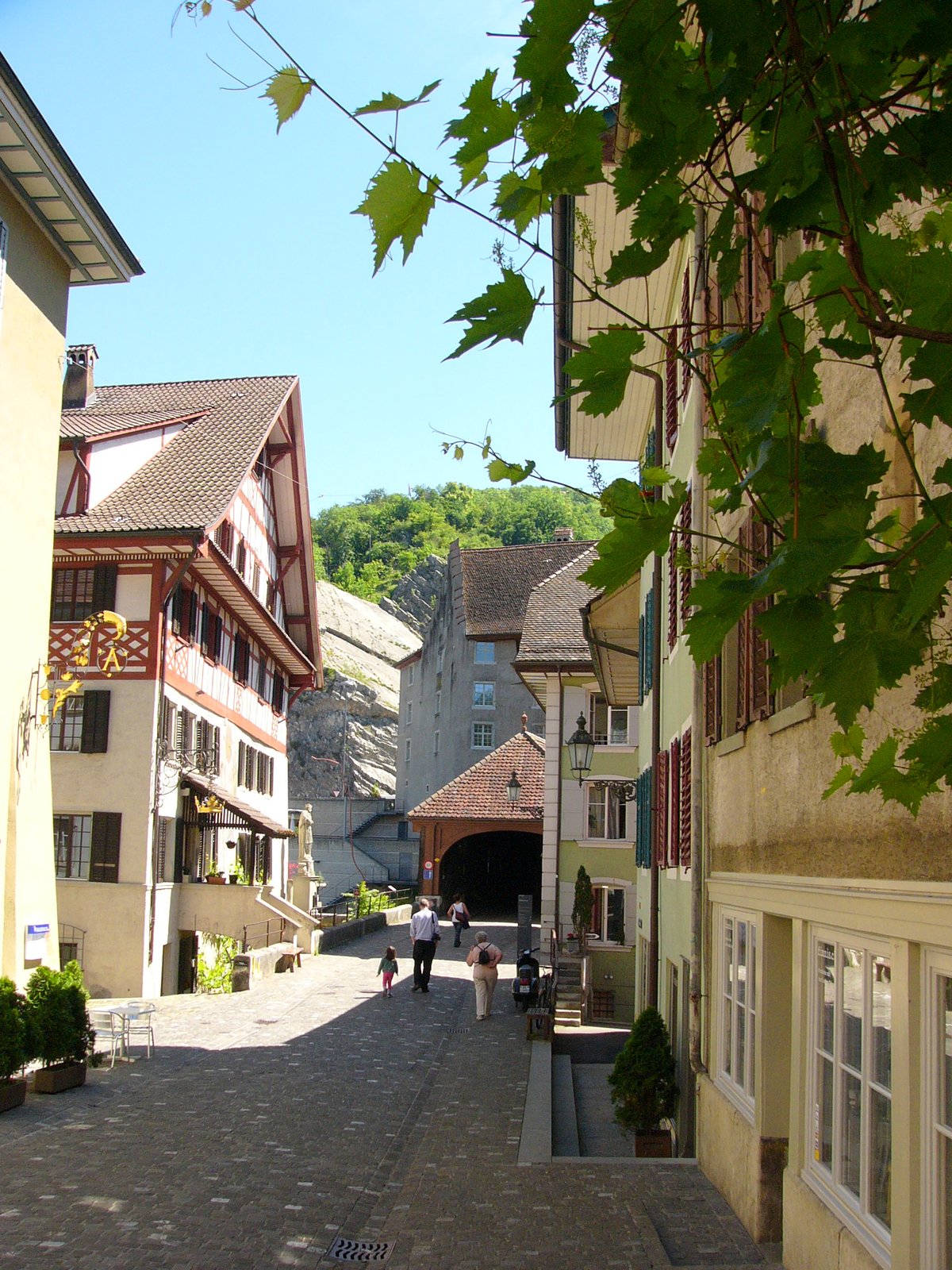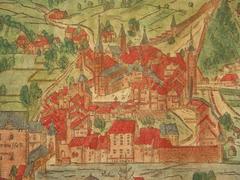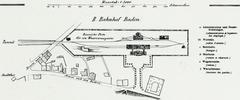
Bailiwick Castle: Visiting Hours, Tickets, and Historical Guide for Baden, Switzerland
Date: 04/07/2025
Introduction
Bailiwick Castle (Landvogteischloss Baden), situated on the right bank of the Limmat River in the historic spa town of Baden, Switzerland, is a remarkable example of medieval architecture and a repository of centuries of regional history. Dating to the 12th century, the castle has evolved from a military fortification to an administrative center and, today, serves as a vibrant historical museum. Its unique blend of well-preserved medieval elements and modern additions—such as the 1990s “Melonenschnitz” extension—offers visitors an immersive journey through Swiss history, culture, and architecture. This guide provides detailed information on the castle’s history, visiting hours, ticket options, accessibility, guided tours, and nearby attractions, ensuring you can make the most of your visit to this iconic landmark (myCityHunt; MySwitzerland; audiala.com).
Table of Contents
- Early History and Medieval Development
- Administrative Role under the Swiss Confederation
- Architectural Evolution
- Political and Social Significance
- Decline, Restoration, and Modern Use
- Visiting Information
- Key Historical Milestones
- Museum Collections and Exhibitions
- Visitor Experience and Architectural Highlights
- Frequently Asked Questions (FAQ)
- Conclusion
- Official Resources and Links
Early History and Medieval Development
Bailiwick Castle’s origins date to the 12th century, when it was constructed as a fortification called Niderhus at the narrowest point of the Badener Klus. Its location, wedged between the Schlossberg and Lägern ridge, was strategically chosen to control access along the Limmat River. The three-story keep, built from rubble and pebbles, reflects the utilitarian military architecture of the era (myCityHunt).
First serving the Counts of Lenzburg, the castle passed to the Counts of Kyburg in 1173 and then to the Habsburgs in 1264 before being fully integrated into Baden’s city fortifications by 1360. Its military purpose was gradually augmented by administrative functions as regional dynamics shifted (myCityHunt).
Administrative Role under the Swiss Confederation
In 1415, the Swiss Confederation conquered Aargau, damaging the castle but quickly restoring it as the seat of the bailiff (Landvogt) of the County of Baden. The annual appointment of a bailiff signified the castle’s central role in regional governance and justice. Niderhus, now known as Landvogteischloss, transitioned from fortress to administrative hub, reflecting the Confederation’s political structure (myCityHunt).
Architectural Evolution
The castle’s architecture is a testament to centuries of adaptation. Its core is a three-story keep, with a main wing forming a bent ellipse, a southern bridge passage, and the Schneggen stair tower on the eastern facade. The most notable modern addition is the 1992–93 “Melonenschnitz” extension by Wilfrid and Katharina Steib, a curved structure that harmoniously merges historic and contemporary design and houses additional museum spaces (myCityHunt).
Political and Social Significance
From 1426 to 1712, Baden became the meeting place for the Swiss Diet, making the castle a center of Swiss political life (audiala.com). The castle and nearby Town Hall (Rathaus), where the Diet convened, symbolize Baden’s prominence in Swiss history. Museum exhibits cover the evolution of civil society, Jewish emancipation, and urban life changes, reflecting the region’s complex social tapestry (MySwitzerland).
Decline, Restoration, and Modern Use
The castle’s administrative role ended with the French Revolution and the Helvetic Republic in 1798. After passing to the Canton of Aargau in 1804 and the city of Baden in 1807, the castle served various purposes, including as a schoolhouse and prison, before falling into disrepair (myCityHunt). A major restoration from 1909 to 1912, led by Otto Dorer, preserved its historic features for museum use. Today, the castle houses the Historical Museum Baden and the city archives, offering exhibitions on Roman heritage, industrialization, and social transformation (MySwitzerland).
Visiting Information
Visiting Hours
- Tuesday – Sunday: 10:00 AM – 5:00 PM
- Thursdays: Open until 8:00 PM
- Closed: Mondays and public holidays
Always check the official museum website for seasonal changes or holiday schedules.
Tickets and Entry Fees
- Adults: CHF 8–10
- Seniors/Students: CHF 5–7
- Children under 16: Free
- Group and guided tour rates: Available upon request
Discounts may apply for Swiss Travel Pass holders or on special free entry days (holidaystoswitzerland.com).
Accessibility
- Wheelchair accessible with ramps and elevators in the modern extension.
- Accessible restrooms available.
- Stroller access is possible in most areas; some historic rooms may have limitations.
- Contact the museum for specific accessibility needs.
Guided Tours and Visitor Tips
- Guided tours (in German, English, French) are available on weekends and by appointment. Booking in advance is recommended.
- Photography is allowed in most areas; non-flash only.
- Visit during weekday mornings or late afternoons for a quieter experience.
- The “Melonenschnitz” extension and Schneggen stair tower are highlights for photography.
Nearby Attractions
- Baden Old Town: Quaint streets, shops, and cafes.
- Thermal Baths: Renowned spa tradition.
- Town Hall (Rathaus): Historic Swiss Diet site.
- Stein Castle Ruins: Panoramic views and hiking opportunities.
- Covered Wooden Bridge (Holzbrücke): Classic Swiss timber architecture.
Key Historical Milestones
- 12th Century: Constructed as Niderhus.
- 1173: Passed to Counts of Kyburg.
- 1264–1273: Acquired by Habsburgs and fortified.
- 1415: Damaged during Swiss conquest; restored as administrative seat.
- 1426–1712: Hosted Swiss Diet sessions.
- 1798: End of administrative use.
- 1804–1807: Acquired by Canton and city.
- 1909–1912: Restored for museum use.
- 1992–93: “Melonenschnitz” extension built.
Museum Collections and Exhibitions
The Historical Museum Baden features:
- Roman spa artifacts (audiala.com).
- Medieval and early modern documents, city models, and photographs.
- Political exhibits on the Swiss Confederation and regional governance.
- Displays on social change, including Jewish emancipation and urban life (MySwitzerland).
- Temporary exhibitions in the modern extension (myCityHunt).
Visitor Experience and Architectural Highlights
Visitors approach the castle via a picturesque wooden bridge, with the castle’s stepped gables and Schneggen stair tower standing out against the Lägern ridge. Inside, historic rooms, irregular floor plans, and period architecture immerse guests in Swiss history. The “Melonenschnitz” extension seamlessly connects historical and modern elements, enhancing the visitor experience (myCityHunt).
Frequently Asked Questions (FAQ)
Q: What are Bailiwick Castle’s opening hours?
A: Tuesday to Sunday, 10:00 AM – 5:00 PM (Thursdays until 8:00 PM); closed Mondays and holidays.
Q: How much is admission?
A: CHF 8–10 for adults; CHF 5–7 for seniors/students; children under 16 free.
Q: Is the castle accessible for visitors with disabilities?
A: Yes, with ramps, elevators, and accessible restrooms.
Q: Are guided tours available?
A: Yes; book in advance for specialized or group tours.
Q: Can I take photos inside?
A: Non-flash photography is allowed in most areas.
Q: Is there parking nearby?
A: Public parking is available in Baden’s center; using public transport is recommended.
Q: What else can I see nearby?
A: Explore Baden Old Town, thermal baths, Stein Castle ruins, and the historic Town Hall.
Conclusion
Bailiwick Castle Baden is a multifaceted destination that seamlessly weaves together Switzerland’s military, political, and social history. From its medieval origins and political significance as the seat of the Swiss Diet, to its role today as a cultural and educational hub, the castle offers a rewarding experience for all visitors. Its accessible facilities, engaging museum exhibits, and proximity to Baden’s most charming attractions make it a top choice for history enthusiasts and travelers alike.
For the most up-to-date information on visiting hours, tickets, and special events, visit the official resources listed below. Enhance your visit by downloading the Audiala app for audio guides and interactive tours, and follow us on social media for news and travel inspiration.
Official Resources and Further Reading
- myCityHunt: Bailiwick Castle Visiting Hours, Tickets & Historical Insights
- MySwitzerland: Historisches Museum Baden
- audiala.com: Bailiwick Castle Baden Historical Significance
- deinbaden.ch: Visiting Bailiwick Castle Baden
- Official Museum Website








